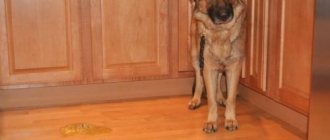An allergy to the Yorkshire Terrier is manifested by hypersensitivity to the fur, excrement and other biological substances of the animal.
Sometimes the body reacts calmly to other animals, while allergic reactions occur to Yorkies.
The Yorkshire Terrier is a small breed.
Many city residents prefer to purchase them, since the dog is compact, visually attractive, has a cheerful, playful character and does not require complex care.
Another advantage of Yorkies is their hypoallergenicity, since these animals do not have an undercoat, and the structure of their coat is close to human hair.
Despite this, some people are still allergic to this breed.
Are Yorkshire Terriers allergenic or not?
Many will say that Yorkshire terriers are practically not subject to shedding, which means where can allergies come from? All breeds, regardless of hair structure and hair loss, have dandruff.
It is characterized by microscopic skin formations that fall off the dog.
If a dog of another breed has an undercoat, then it produces more dandruff. Yorkshire Terriers have only one coat. This means that dead epidermal cells will fall off from them at half the rate.
For this reason, Yorkshire Terrier dogs cannot be called completely non-allergenic animals. They simply emit fewer allergic substances.
Another allergen can be animal saliva, or rather the proteins that are present in it..
Allergic effects can occur in this way:
- Signs of an allergy appear after your pet licks your hand.
- It is customary for animals to lick their fur. Therefore, after such a toilet, if you stroke a Yorkie, an allergy may begin to appear and this will not depend on its fur.
- A dog's face always contains a certain amount of saliva.
- Dog saliva and even urine can get on things, floors, rugs, furniture, and in all places where the pet is.
In addition, a dog, returning from a walk, may carry pollen or mites on its fur . Any of this irritant is capable of causing a response from the human body.
Expert opinion
Tolkachev Andrey Mikhailovich
veterinarian
If you have an allergy and there is a Yorkshire terrier in the family, you must take an allergen test. He will determine what exactly a person has such a reaction to. If it turns out that you are really allergic to dog dander, you should not try to get rid of your pet right away. Try bathing your dog every two weeks, but not more often, as this will make your dog's skin even drier. Don't let your Yorkie into your bedroom, because that's where the person spends more than 8 hours a day. You should wash your hands more often, even if there has been no contact with the dog, and you should also undergo a course of immunotherapy.
How to understand that the cause of an allergy is a Yorkie
To check whether your Yorkshire pet is involved in unpleasant symptoms, you need to exclude contact with the dog for a while. If the body's condition returns to normal, then the pet is really to blame for the problem.
To confirm the diagnosis, you should contact a medical laboratory, take a blood test, and do an allergy test. If the Yorkie has become a provocateur of poor health, then:
- the concentration of immunoglobulin in the blood will be increased;
- The test result will be a skin reaction in the form of swelling and irritation to the dog protein.
Causes of allergies to Yorkies
It is worth considering the most common causes of allergies to the Yorkshire Terrier:
- Protein is a protein formed as a result of the activity of the terrier's sebaceous glands. This substance can be present in urine, sebum, salivary fluid, and animal feces.
- Parasites that live on the terrier's fur, which can also get on human skin by biting him. In response to this, an allergic reaction develops.
- Dirt and dead cell structures on a terrier's coat. If these microelements penetrate the human respiratory tract, a response will develop in the body.
- Subcutaneous fat secreted by a dog's sebaceous glands, containing essential oils to which some people are particularly sensitive.
- Pollen from various plants can settle on the animal's fur. This is a seasonal feature and pollen allergies are often confused with Yorkie allergies.
- Dog feces or blood may come into contact with a sensitive person's skin, causing skin rashes (including eczema).
What should an owner with allergies do?
First of all, the owner of a Yorkshire Terrier must get rid of allergens accumulated in the home:
- ventilate the premises;
- clean the house using a vacuum cleaner;
- wipe dust from shelves and cabinets;
- wash the dog bed;
- clean carpets and upholstered furniture;
- buy an air purifier.
It is necessary to clean the rooms regularly and wash your hands after contact with the dog. But sterility is undesirable; it will lead to a deterioration in health. To adapt, the body must constantly fight stimuli.
Your Yorkie should be bathed 2 times a week. More often than not, it’s not worth it, otherwise the terrier’s skin will begin to irritate and peel. For bathing, anti-allergenic zoo shampoos that neutralize dangerous proteins are recommended. The dog's coat must be combed regularly to remove exfoliated skin cells, and we must not forget about antiparasitic treatment.
The Yorkshire Terrier should not be allowed into the bedroom, especially into the bed. The bedroom is the place where residents spend most of the day, so it should remain clean.
An allergist prescribes for course use:
- antihistamines (Zodak, Suprastin, Zyrtec, Lomilan);
- decongestants (Afrin, Sudafed);
- nasal sprays for runny nose (Nasonex, Allergodil);
- medications for itching and dermatitis;
- eye drops for conjunctivitis;
- activated carbon and other sorbents for diarrhea;
- vitamin and mineral complexes.
For severe allergies, the specialist prescribes corticosteroids in tablet or injectable form.
Yorkshire Terriers are small and produce small amounts of saliva and skin secretions, which reduces the risk of allergies, but does not eliminate them. In order not to give your pet away, you should keep the apartment clean and follow the rules of hygiene. If the allergic reaction to a Yorkie is severe, then you will have to say goodbye to the animal.
SIMILAR ARTICLES
HOW TO CUT YOUR YORKSHIRE TERRIER
There are many types of Yorkie haircuts. In this article we will figure out which haircuts are suitable for Yorkies...
CARRY FOR YORKSHIRE TERRIER
Every happy Yorkie owner wants to spend as much time as possible with his furry dog. where would you...
WHAT TO FEED A YORKSHIRE TERRIER PUPPY
When getting a Yorkshire Terrier puppy, it is first of all important to find out what to feed him. This is a small dog with...
HOW TO CARE FOR YOUR YORKSHIRE TERRIER
For many people, choosing a Yorkshire Terrier as a pet is based on its small size...
CREATIVE HAIRCUT FOR YORKSHIRE TERRIERS
The most popular creative Yorkie haircut, ideal for babyfaces. This sweet and naive face is at its peak...
YORKSHIRE TERRIER - DESCRIPTION AND CHARACTER OF THE BREED
More and more people are choosing Yorkshire Terriers as pets. But what did this breed deserve...
IS IT ALLERGY TO YORKSHIRE TERRIERS?
Many breeders believe that the Yorkshire Terrier is a hypoallergenic dog that can be safely owned by a person…
WHEN DO THE YORKSHIRE TERRIER'S EARS STAND UP?
The Yorkshire Terrier breed has its own standards, which indicate that a Yorkie’s ears must…
COMBES FOR YORKIES. WHICH ONE TO CHOOSE?
It's time to figure out what combs for Yorkies you need to have. Success in grooming on...
HOUSE FOR YORKSHIRE TERRIER
A house for a Yorkie? What are you talking about! This is a super sociable, curious dog who strives...
TOP 5. THE MOST BEAUTIFUL DOG BREEDS
Perhaps the very first animal with which people shared their home was a dog. Subsequently this...
Symptoms in children and adults
So, if you are allergic to Yorkies, symptoms will appear soon.
They cause a lot of inconvenience, interfere with normal life, work, and sometimes cause serious complications.:
- Nasal congestion, runny nose, sneezing.
- The appearance of shortness of breath and cough, sometimes accompanied by wheezing.
- Watery eyes, photophobia, red eyes.
- Peeling areas appear on the skin or a rash develops in the form of pale pink blisters.
- Problems with the gastrointestinal tract, a gag reflex and diarrhea may appear.
- Dermatitis most often develops on the hands, body and face.
CAREFULLY!
Dangerous consequences of an allergic reaction can include anaphylactic shock and Quincke's edema. If timely assistance is not provided, death occurs in a matter of time.
It is worth remembering that the symptoms in children are the same, but they are more intense..
Causes and symptoms of allergies to Yorkshire Terrier
Animal fur does not play a decisive role in the occurrence of allergies. It only promotes the movement of proteins - the main danger, which are released with saliva, fluids from the glands, feces, tears, etc. Dandruff and fur are also “carriers” of dangerous proteins, especially the undercoat. Due to the absence of a second layer of coat in Yorkies and the smooth structure of their hair, they can be classified as rarely causing allergic reactions.
Trimmable rocks have similar properties. Their mature fur is very difficult to shed without assistance. When the time comes, the dead hairs are plucked out and combed out by hand, and during walks the old fur remains on branches and tall grass. Returning to Yorkies, we can talk about other advantages for allergy sufferers. Thanks to frequent washing and haircuts, the risk of getting an unpleasant response from the body is reduced.
A simple mechanism for the occurrence of allergies will help to understand why it occurs in dog owners. The pet licks itself, goes to the toilet, leaves marks and substances from the glands throughout the house. Even with regular care and frequent cleaning of the house, they remain. The proteins in these substances enter the human body, where they are met by the immune system and, in the event of any failure, react incorrectly to them. It can take a lot of time to develop. Sometimes one contact with an animal is enough, but in other cases a cumulative process occurs and the disease manifests itself after years of living next to the pet.
The symptoms of a Yorkie allergy are also ambiguous for everyone. Experts point out the different nature of the manifestations and the fact that an allergy to dogs cannot always be determined accurately, especially with the same reaction to many foods, pollen, and medications. These symptoms will show how an allergy to a Yorkie manifests itself:
- Runny nose;
- Tearing;
- Redness of mucous membranes;
- Red spots on the skin;
- Shortness of breath, sore throat and swelling;
- Sneezing;
- The skin itches in some places.
Rare symptoms:
- Anaphylactic shock;
- Quincke's edema.
Helped you learn a little more about the Yorkshire Terrier breed? Read our other articles on the website: Raising and training the Yorkshire Terrier
Could it not appear immediately?
An allergic reaction does not always appear immediately. This kind of allergy is called accumulative, when the allergen accumulates in the blood, and then after a certain time begins to manifest itself in various allergic reactions.
This kind of allergy is most unpleasant, since household members have time to get used to the small dog and it will be much more difficult to part with him.
But there is also a temporary allergy, when the first time after the dog appears in the house, one of the family members develops allergic symptoms.
Over time, after the body adapts, these symptoms disappear.
Yorkshire Terrier color
The color and quality of the coat is one of the main indicators of compliance with the breed standard. Yorkshire Terrier puppies are born completely black, with several “tan” spots on the face, hind legs, chest and under the tail. Over time, the color begins to change, but it is almost impossible to understand exactly what it will become. Although breeders initially “cull” puppies that were born without the characteristic tan spots. It is not customary to expect that the color of such babies will correspond to the standard.
As a dog gets older, its coat becomes lighter. In a professional environment, the change in color is called recoloring. It starts from the head: golden-bronze takes the place of black or brown fur. The steel color appears more and more on the neck and back. Gradually, no black spots remain on the head at all, and the body acquires a characteristic dark, bluish-steel color. There should be no inclusions of other shades: the wool shimmers only in transitions from dark to light. Recoloration can last quite a long time; Yorkshire terriers usually acquire their “finished” color by two to three years.
The quality of wool also changes. In puppies it can be fluffy, but by adulthood it should become absolutely even throughout the entire body and silky. It is noted that dogs whose color is dominated by light tones usually have better coat quality than dark ones. This does not apply to Yorkshire Terriers and Biewers. Black and white babies were bred in Germany a little over 30 years ago, and the breed standard was approved only in 2007. Their color may be more original: with a transition from golden to black, with a luxurious white chest.
Diagnostic methods
To know what specific irritant affects the dog breeder and to make a correct diagnosis, you need to see an allergist. He will order a series of tests and skin tests.
The most effective is a skin test . The suspected allergen is injected under the skin.
You can enter up to 15 copies at a time. If there is a skin reaction, it means the person has increased sensitivity to this substance.
A blood test is required to find out what the general condition of the body is..
Preventive measures
If a person who has interacted with a decorative beauty shows signs of allergies, he needs to take an antihistamine and consult a doctor. After consulting a specialist and collecting the necessary tests to make a diagnosis, it will be clear what exactly was the factor provoking a new round of the disease.
Until the cause is determined, it is better for a person to avoid contact with a dog. Yorkie can be moved to a separate room or given to relatives for foster care. In particular, such measures need to be taken by parents whose child is allergic.
If there is no way to limit communication with the animal, then the patient must be removed from walking and caring for the Yorkie. Feeding and bathing the animal should also be entrusted to someone else. The house or apartment in which the patient and the dog live must be frequently ventilated and wet cleaned. Washing carpets, dusting upholstery and washing curtains will also be useful.
Important! The bed on which the dog usually sleeps also needs to be cleaned of hair and dust several times a day, thereby relieving it of the accumulation of allergens.
People who suffer from allergies, but cannot imagine their life without their beloved Yorkshire Terrier, install air filters in their apartments, which do an excellent job of cleaning it from allergens and micro-dust particles.
Similar articles
Treatment Options
The following treatment methods are available:
- Prescription of antihistamines and anti-inflammatory medications, such as Zodak, Erius, Suprastin, Loratadine. Thanks to them, the immune system begins to fight the irritant and the consequences of its impact.
- If conjunctivitis is detected, eye drops are prescribed. For rhinitis, antiallergic nasal drops are prescribed.
- For skin rashes, you will need appropriate gels, ointments and other local products.
- If antihistamines have no effect, the doctor switches to stronger medications - glucocorticosteroids, which contain hormones.
- Sometimes a course of hyposensitization is carried out. It is aimed at reducing sensitivity to irritants. During the session, the patient is given a small dose of the allergen. As a result, the body begins to produce elements that can suppress allergic proteins. After getting used to it, the catalyst is canceled. This treatment lasts from two weeks to 12 months. This will depend on the degree of allergy and the individual characteristics of the patient. The number of injections and dosage of the medicine are determined by the doctor, since inappropriate use of the treatment can cause life-threatening reactions. But a weak solution or an insufficient number of injections will not give the desired result.
- And another important point in the treatment of allergies is immunotherapy. Without it, a weakened body will not be able to properly resist external attack.
Symptoms and signs
Common symptoms include the following:
- Runny nose. Even in the absence of discharge, swelling of the nasal membranes occurs. This makes breathing difficult.
- Tearing. Often accompanied by discomfort in the eyes, foreign body sensation, and burning sensation.
- Redness of the mucous membranes. It manifests itself most clearly in the oral cavity: sometimes the throat turns red.
- Skin rashes. They look like red spots.
- Dyspnea. Occurs at rest, not after physical activity.
- Coughing and sneezing. The patient's throat is sore, he feels discomfort, and cannot clear his throat.
- Itching. The rashes are itchy. There may be a feeling of heat in the affected areas.
Occasionally, with severe reactions, patients experience anaphylactic shock or Quincke's edema. The first is an immediate allergic reaction and is characterized by greatly increased sensitivity of the body.
Symptoms appear almost instantly. The dose and speed of allergen administration do not matter, so preventive measures against anaphylactic shock do not save. Symptoms include severe itching, swelling, swelling of the larynx, spasms and difficulty breathing. In the absence of help, a person loses consciousness and may die.
Quincke's edema is expressed as the appearance of swelling throughout the entire area of the face or in a separate part of it. First of all, this condition is dangerous due to swelling of the larynx. In this case, the person loses the ability to breathe normally.
Common symptoms include hoarseness, cough, redness and subsequent paleness. The patient is breathing noisily and has difficulty inhaling. Without help, the person falls into a coma, which can lead to death.
The child has
In children, the immune system is weaker because it is not fully developed. They are more likely to develop severe conditions such as Quincke's edema or anaphylactic shock. There is a risk of asthma.
In children, allergy symptoms may resemble a cold or indigestion. The child suffers from red eyes, watery eyes, sneezing, coughing, and difficulty breathing. This is accompanied by vomiting, nausea, diarrhea and refusal to eat. The skin at the site of contact with the animal sometimes turns red.
In an adult
The adult body is more resistant to allergens, so severe reactions are observed less frequently. The condition is getting worse gradually. First, nasal congestion occurs, then discomfort in the eyes, sneezing and coughing occurs. Diarrhea develops.
If a person continues to be near the source of allergens and does not take medications, redness appears on the skin. They itch. Breathing becomes difficult. Swelling and suffocation are a concern. With prolonged contact with the allergen, dermatitis may develop.
Preventive actions
If you have already had cases of allergies to Yorkies, then when purchasing this compact dog you should immediately take care of preventive measures, they consist of the following steps:
- You will have to clean up after your pet more responsibly, and do it as often as possible.
- Disinfect areas where the dog most often lives, and perform all actions with gloves.
- To reduce the risk of dust and animal skin particles getting on the bed, you need to use pillowcases, duvet covers and sheets, and change them regularly.
- Carry out wet cleaning daily.
- It is better to get rid of large carpets with long pile, replacing them with thinner ones, which will simplify cleaning the room.
- Do not allow your Yorkie to be on beds, chairs, or sofas.
- When bathing your dog, use special products, and also trim your Yorkshire Terrier regularly.
- Strengthen your immune system, exercise, eat right, and worry less.
If all these measures do not produce positive results, then it is better to put health first and place your pet in another family.
Description of the Yorkshire Terrier breed
These are small dogs with a very strong build. According to the standard, the weight of a Yorkshire Terrier should not exceed 3.2 kg. There is no minimum limit. However, it has been noted that how long Yorkshire terriers live at home seriously depends not only on care and nutrition, but also on the weight of the pet. The less a dog weighs, the shorter its life expectancy. Therefore, the desire to choose a miniature Yorkie for keeping in an apartment is a tribute to fashion, not common sense. According to the breed standard, representatives that are too small are considered a breeding defect and are prohibited from being used for mating, breeding, or participating in exhibitions.
The compactness of Yorkies is complemented by their grace and even a certain pride in their gait. They have a small head with triangular, high-set ears, a short muzzle, a regular bite and dark, shiny, small eyes. Breeders say that the dog's gaze is intelligent and alert. And even just by the “expression” of the muzzle one can distinguish a real Yorkshire terrier from its baby-face “variety”.
This is the name given to Yorkie dogs with a particularly short muzzle and bulging, as if surprised, “childish” eyes. These babies look, of course, touchingly, but they don’t fit into the standard. Experts give preference to the “classic” structure of the Yorkshire Terrier’s muzzle, while the baby face is considered a defect.
The body structure of the Yorkie is noticeable: an absolutely straight back, a narrow chest and completely straight hind legs. It used to be customary to dock the tail, but today the right to shorten it or leave it as is is given to the discretion of the breeder. Therefore, more and more Yorkies are appearing with medium-length tails, which are usually raised to the same level as the back line and end in a fun tassel.
Hypoallergenic shampoos
To neutralize the effects of proteins secreted by the animal’s body, you can use anti-allergenic shampoos, which are available in specialized stores.
These shampoos also contain substances that prevent dry skin of terriers and fight parasites such as fleas and ticks.
If you choose the right product, you can ensure that the protein does not spread to the animal’s fur.
How much does a Yorkshire Terrier puppy cost?
Dogs of this breed have become very popular in Russia. More than 70 nurseries that specialize in breeding Yorkies are registered in the national club. You can buy a puppy either from a kennel or from someone else, and prices will vary greatly.
The price tag for babies from a nursery can be steep; it starts from 25 thousand rubles and can reach up to 70 thousand rubles. Private owners sell puppies cheaper - 7-14 thousand rubles. When choosing a pet, pay attention to its color, since deviations from the standard speak not so much about the decorative qualities of the dog, but about possible health problems in the future. Look for a puppy with documents, since the presence of a pedigree confirms that this is, indeed, a Yorkie, and not a cross between an unknown breed.
Room care
It is advisable to immediately purchase a vacuum cleaner with fine filters together with your dog..
If there is no such filter, then the vacuum cleaner will simply chase small hairs around the apartment.
It is known that allergens can accumulate on carpets, soft toys, and furs. It is advisable to get rid of such items; fur products should be stored in special cases.
In the store you can buy sprays against animal allergies, which are sprayed where dogs stay..
Air purifiers are installed in the sleeping area, which can neutralize the allergic protein secreted by Yorkshire terriers.
Preventing pet allergies
One of the pressing questions is whether it is possible to prevent allergies to the Yorkshire Terrier. Regular hygiene and care of the animal minimizes the risk of negative reactions and reduces their intensity.
For your information. A person must pay attention to his own health. It is recommended to eat right, exercise, and be less stressed.
A Yorkshire Terrier can provoke an allergy if it itself gets sick.
A sick Yorkie develops:
- dandruff;
- excess sebum production;
- metabolic disease;
- malfunctions of internal organs, which can cause allergies.
To prevent health problems, you should take your Yorkshire Terrier to the veterinarian for a preventive examination at least once a year.
For your information. Often, dandruff in Yorkshire terriers appears due to the consumption of chicken meat. It is necessary to exclude it from the diet, and the problem will quickly disappear.
Hygiene and room care
In the house where the Yorkshire Terrier lives, disinfection, wet cleaning and ventilation should be carried out regularly, even if there are no prerequisites for allergic reactions yet, but the owners have previously experienced increased sensitivity to irritants.
Thanks to this, the room is cleared of fallen hairs and particles of the epidermis.
Experts advise adhering to the following recommendations:
- Use a vacuum cleaner with a fine filter for cleaning - it traps small particles rather than chasing them around the house.
- Remove carpets, bedspreads, soft toys and other things in which allergens accumulate.
- Store fur coats and other fur products in covers.
- Keep your Yorkshire Terrier out of the bedroom and other rooms where the allergy sufferer spends a lot of time.
- Buy a medical air purifier with antibacterial lamps.
- Wash your hands after each contact with the Yorkshire Terrier, wash and shower more often in order to quickly cleanse the skin and mucous membranes of irritating agents.
Pharmacies sell anti-allergy sprays, which it is advisable to use in areas where the Yorkshire Terrier visits most often.
How to care for your pet
Regular hygiene procedures help remove allergens from wool.
For this Yorkshire Terrier:
- brushed daily;
- treated against worms and blood-sucking parasites;
- cut as short as possible;
- bathe once a week with hypoallergenic shampoos.
In the summer, it is advisable to carry out manipulations outside the apartment so that all irritants remain outside.
For your information. You should also not bathe your Yorkshire Terrier too often - there is a high risk of drying out the skin, which will lead to dandruff.
Once they know if a family member has allergies, care and feeding responsibilities are assigned to another person to minimize contact with the dog.
If this is not possible, when communicating with a Yorkshire terrier, an allergic person should wear a mask, gloves and special clothing.
Are there hypoallergenic Yorkies?
Yorkie fur, due to its structure and lack of undercoat, does not cause allergies. In addition, the small size of the dog will prevent negative substances from spreading in large quantities.
But nevertheless, any animal, including Yorkies, can cause allergic reactions due to the release of a special allergic protein.
IMPORTANT!
There are no 100% hypoallergenic Yorkies, they just produce far fewer allergens that some people may find sensitive.
Treatment of allergic manifestations
Before starting treatment, you need to make sure that the patient has an allergy and not some other disease, since its symptoms are often similar to infectious-inflammatory and skin diseases.
Allergies to Yorkies are treated similarly to other varieties. The main group of drugs is antihistamines (Claritin, Zyrtec, Benadryl). They block the production of histamine, relieving pathological symptoms.
Antihistamines can be local - in the form of ointments and creams (effective for skin manifestations), and systemic (suppress any signs of a reaction).
In addition to them are used:
- decongestants (useful for severe swelling of the skin and mucous membranes);
- nasal drops (eliminate allergic rhinitis);
- enterosorbents (needed to cleanse the body of toxins);
- immunostimulants (help strengthen the immune system and prevent relapses);
- hormonal (they are used only for severe allergies).
Additional medications are prescribed as symptomatic therapy to eliminate the most disturbing features.
If the reaction reappears, you should use antihistamines recommended by your doctor.
Video about allergy medications:
It is very important to neutralize the effect of the traumatic factor - this will help prevent new exacerbations. To do this, you need to find out what exactly provokes the reaction: dog hair, saliva or other reagents that are only tolerated by the pet.
If the patient is sensitive to pollen or chemicals that can collect on the pet's fur during walks, the dog must be thoroughly hygienic. Allergy sufferers do not need to come into contact with the dog immediately after a walk.
If you are sensitive to fur or natural secretions, it is necessary to limit the patient’s interaction with the animal. Sometimes it makes sense to give the dog to relatives or friends, since due to constant contact with the irritant, the patient’s condition may worsen.











